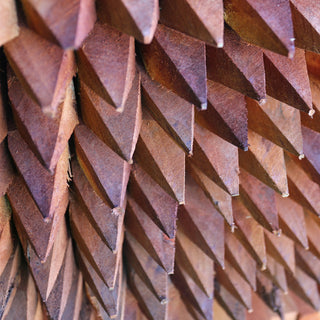When it comes to supporting and protecting young trees, two commonly used tools are tree guards and tree stakes. While both serve important roles in the early stages of a tree’s life, they are designed for very different purposes and are best used in specific scenarios. Understanding when and how to use each can be the difference between a thriving tree and one that struggles to survive.
In this post, we’ll explore the core differences between tree guards and tree stakes, outline when to use each, and help you decide which product (or combination of both) best suits your planting project.
What Are Tree Stakes?
Tree stakes are rigid supports, typically made from timber, bamboo, or plastic , that are driven into the ground near a tree to help stabilize it during establishment. Their primary role is to support the trunk and root ball, preventing the tree from tilting or being uprooted by wind, animals, or uneven soil conditions.
When to Use Tree Stakes
-
Newly Planted Trees
-
Young trees with underdeveloped root systems often require support to prevent movement that can inhibit root establishment.
-
Stakes provide mechanical support during this vulnerable period.
-
In Exposed or Windy Sites
-
Areas prone to strong winds benefit from staked trees, reducing stress on the trunk and anchoring the root zone.
-
Tall, Bare-Root, or Top-Heavy Trees
-
Taller or unbalanced specimens may not be able to support themselves fully, especially during early growth.
-
When Planting on Slopes or Soft Ground
-
Uneven terrain or loosely packed soil can cause instability; staking helps secure the tree’s position.
Types of Tree Stakes
At StrataGreen, you’ll find a wide range of high-quality tree stakes:
-
Hardwood Stakes - Long-lasting and ideal for most landscaping jobs.
-
Bamboo Stakes - Great for smaller trees or shrubs and more economical. .
-
Recycled Plastic Stakes - Sustainable option for most landscaping projects.
What Are Tree Guards?
Tree guards are protective barriers placed around the base of a young tree. Their main role is not support, but protection, shielding the trunk and lower stem from environmental threats such as animals, herbicides, mechanical damage (e.g., mowers or trimmers), and harsh weather conditions.
When to Use Tree Guards
-
In Areas with Grazing Animals or Wildlife
-
Rabbits, wallabies, kangaroos, and livestock can damage or eat young shoots and bark. Guards provide a crucial physical barrier.
-
During Weed Control and Herbicide Application
-
When spraying herbicides near new plantings, tree guards protect the delicate stems from chemical exposure.
-
Urban or High-Traffic Environments
-
In parks, streetscapes, or school grounds, guards prevent accidental knocks or vandalism.
-
To Improve Microclimate
-
Some guards help maintain moisture, moderate temperatures, and create a mini greenhouse effect that can accelerate growth.
Types of Tree Guards
StrataGreen offers a variety of tree guards tailored to different applications:
-
Plastic Sleeves - Lightweight, economical, and recyclable. .
-
Mesh Guards - Provide airflow while preventing animal browsing.
-
Corflute Tree Guards - Durable, UV-stable, easy to install and used extensively in revegetation projects.
-
Eco-Friendly Options from cardboard or bio-plastic - Ideal for sustainable landcare initiatives.

Tree Stakes vs Tree Guards: Key Differences
|
Feature |
Tree Stakes |
Tree Guards |
|
Main Purpose |
Support |
Protection |
|
Material |
Timber, plastic, bamboo |
Plastic, cardboard, corflute, bio-plastic |
|
Installation |
Driven into the ground |
Placed around the trunk |
|
Common Use |
Stabilizing newly planted trees |
Preventing animal/chemical damage |
|
Effect on Growth |
Keeps trees upright |
Creates a protected microenvironment |
Can You Use Both Together?
While it’s technically possible to use tree stakes and tree guards together for plant support, it’s not common. Tree guards are typically used on smaller plantings, such as tubestock, which don’t require staking to support the plant itself.
However, stakes are almost always used to support the tree guard. Bamboo canes or smaller timber stakes are inserted to hold the guard upright, ensuring it stays in place and provides reliable protection against animals, wind, and mechanical damage.
Example Scenario:
You’ve planted tubestock in a revegetation project. The seedlings don’t need staking for stability, but you install a corflute guard to protect them from rabbits and kangaroos. A pair of bamboo stakes is used to hold the guard in position, keeping the protection secure as the plant establishes.
Best Practices for Using Tree Stakes and Guards
-
Don’t Over-Stake: Only stake trees that need support. Over-staking can lead to weak trunks that don’t develop proper structural strength.
-
Use Soft Ties: Avoid tying trees too tightly; use soft, flexible materials to allow some movement (this helps the tree build strength).
-
Check Regularly: Inspect stakes and guards every few months. Remove or adjust them as the tree matures.
-
Choose Recyclable or Biodegradable Products Where Possible: Many tree guards and ties are now made from materials that break down over time or can be reused across planting cycles.
Final Thoughts
While they may seem interchangeable, tree stakes and tree guards serve distinct and complementary roles. Stakes help young trees stay upright, while guards shield them from threats. Using the right tool at the right time ensures better survival rates, faster growth, and long-term resilience for your trees.
Whether you’re a landscaper, contractor, revegetation volunteer, or home gardener, choosing quality supplies is essential. StrataGreen stocks a comprehensive range of tree stakes and tree guards trusted by professionals Australia-wide. Equip your project with the right tools, and your trees will thank you for it.


